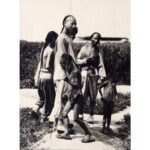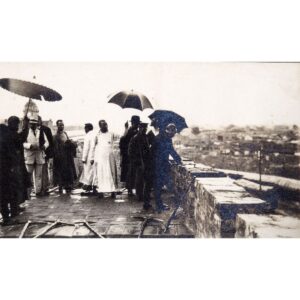Photography Young Chinese women
A black-and-white photograph, a studio portrait of three young Chinese women in traditional dress sitting in front of a screen. They are wearing the type of clothing that Han Chinese women wore in the 19th and 20th centuries. In the Qing Dynasty (1644–1912) women wore Manchu clothing less often than men, and liked to combine different styles. The fashion that prevailed in the Ming Dynasty (1368–1644) was particularly popular. Newlyweds wore the traditional garment ruqun 襦裙, consisting of a blouse (ru 襦) and a skirt (qun 裙). It was worn by women as early as the Warring States period (476–221 B.C.) and became the most popular garment for women in the Ming Dynasty. The sleeves changed from a tapered to a straight shape. The silk jacket has a characteristic Huling 護領 protective collar. In the late Qing Dynasty, this gradually covered the entire neck. In the Qing Dynasty, women most often wore a pleated skirt (baizhequn 百摺裙), literally “hundred-layered skirt”. ... more
A black-and-white photograph, a studio portrait of three young Chinese women in traditional dress sitting in front of a screen. They are wearing the type of clothing that Han Chinese women wore in the 19th and 20th centuries. In the Qing Dynasty (1644–1912) women wore Manchu clothing less often than men, and liked to combine different styles. The fashion that prevailed in the Ming Dynasty (1368–1644) was particularly popular. Newlyweds wore the traditional garment ruqun 襦裙, consisting of a blouse (ru 襦) and a skirt (qun 裙). It was worn by women as early as the Warring States period (476–221 B.C.) and became the most popular garment for women in the Ming Dynasty. The sleeves changed from a tapered to a straight shape. The silk jacket has a characteristic Huling 護領 protective collar. In the late Qing Dynasty, this gradually covered the entire neck. In the Qing Dynasty, women most often wore a pleated skirt (baizhequn 百摺裙), literally “hundred-layered skirt”. Chinese women often used hair ornaments, adorning their heads with various accessories, from the most prestigious – the phoenix crown, which could weigh several kilograms – to simpler hairpins, clips and bobby pins. The young women in the photo are wearing lotus shoes ( lianlü 蓮履), a type of conical shoe worn by women with bandaged feet. The shoes, sewn from silk or bamboo, were the same size as the palm of a hand. Some also had a heel or a thickened sole.
Clothes and shoes are made in different styles and colour combinations with original decorations – embroideries with animal and flower motifs. The girl in the centre is wearing a dress with embroidered chrysanthemum flowers (juhua 菊花). The symbolic meaning of the chrysanthemum, sincerity and perseverance, comes from the fact that it blooms on cold winter days and heralds the arrival of winter.
Portrait photography became the most popular genre in China after photography “conquered” the country. After only a few years, photography supplanted portraiture wherever Westerners were present, and later spread to other places. The reason is simple: portraiture was an important tradition in both China and the West even before photography. It was one of the few areas of interest common to both cultures.
The photograph is the 152nd of 449 photographs of Beijing and its surroundings in the album of Ivan Skušek Jr., purchased during his stay in Beijing (1914–1920). In the handwritten inventory of the album, the photograph is referred to as Junge Chineserin. (DZ, MV)





































Do you have a comment or additional information about the subject?